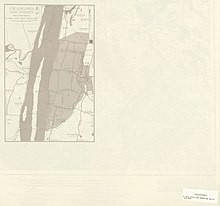Citations:Ch'ang-sha
Jump to navigation
Jump to search
English citations of Ch'ang-sha


- [1964, Sherman E. Lee, “Chinese Art of the Shang and Chou Dynasties”, in A History of Far Eastern Art[1], New York: Harry N. Abrams, Inc., Publishers, →LCCN, →OCLC, page 49, columns 1, 2:
- In addition to glazed ceramics we have, for the first time, actual remnants of wood — not simply imprints in the earth like those found at An-Yang. The first discovery of these woods was an accident, occurring at railroad excavations of the early 1930s in the South China province of Hunan, at the city of Ch’ang-Sha.]
- [1966, John E. Rue, “The General Front Committee”, in Mao Tse-tung in Opposition, 1927-1935[2], Stanford, Cali.: Stanford University Press, →LCCN, →OCLC, page 215:
- The First Army Corps attacked Nanch'ang on August 1, but failed to capture it. […] In the meantime, P'eng's Third Army Corps had captured Ch'angsha on July 29 and proclaimed a soviet government of three provinces (Kiangsi, Hunan, and Hupeh), with Li Li-san as its chairman in absentia.]
- 1969, Yi-Fu Tuan, China[3], Chicago: Aldine Publishing Company, →ISBN, →LCCN, →OCLC, page 22:
- Aside from the Turfan depression in Hsin-chiang (Sinkiang) province, the hottest part of China lies in the middle and lower Yangtze Valley. Maximum temperatures of 43°-44°C (110°-112°F) have been recorded in Ch'ang-sha and Nan-ching.
- 1972, Wu-chi Liu, Su Man-shu[4], New York: Twayne Publishers, →LCCN, →OCLC, page 29:
- To implement the triple revolutionary strategies of propaganda, insurrection, and assassination, members of the association one after another departed for home to start revolutionary movements in their native districts. Huang Hsing returned to Ch'ang-sha; Ch'in Yü-liu went first to Shanghai and thence to Ch'ang-sha at Huang Hsing's invitation.
- 1979, Gary May, China Scapegoat: The Diplomatic Ordeal of John Carter Vincent[5], Washington, D.C.: New Republic Books, →ISBN, →LCCN, →OCLC, →OL, page 37:
- His dislike for Hankow made him miss Ch'ang-sha all the more, and he longed for some word of conditions in the province from clerk J. S. Pan who had remained behind to watch over American interests. A few weeks after his arrival, he received his first bit of news from Ch'ang-sha, but it did little to brighten his spirits. "Ch'ang-sha has been under the control of the Communist Party since April 8th," Pan wrote Vincent.
- [1983, Harrison E. Salisbury, “Moscow Takes a Hand”, in China: 100 Years of Revolution[6], →ISBN, →OCLC, page 69:
- In the spring of 1921 Siao Yu came back to Chang-sha.]